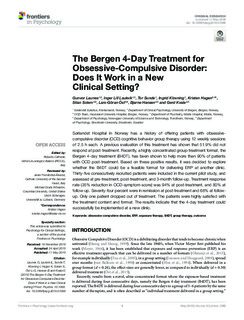| dc.contributor.author | Launes, Gunvor | |
| dc.contributor.author | Laukvik, Inger Lill | |
| dc.contributor.author | Sunde, Tor | |
| dc.contributor.author | Klovning, Ingrid | |
| dc.contributor.author | Hagen, Kristen | |
| dc.contributor.author | Solem, Stian | |
| dc.contributor.author | Øst, Lars Gøran | |
| dc.contributor.author | Hansen, Bjarne | |
| dc.contributor.author | Kvale, Gerd | |
| dc.date.accessioned | 2019-10-01T06:08:55Z | |
| dc.date.available | 2019-10-01T06:08:55Z | |
| dc.date.created | 2019-07-08T11:29:53Z | |
| dc.date.issued | 2019 | |
| dc.identifier.citation | Frontiers in Psychology. 2019, 10 (1069), 1-8. | nb_NO |
| dc.identifier.issn | 1664-1078 | |
| dc.identifier.uri | http://hdl.handle.net/11250/2619458 | |
| dc.description.abstract | Sørlandet Hospital in Norway has a history of offering patients with obsessive-compulsive disorder (OCD) cognitive behavior group therapy using 12 weekly sessions of 2.5 h each. A previous evaluation of this treatment has shown that 51.9% did not respond at post-treatment. Recently, a highly concentrated group-treatment format, the Bergen 4-day treatment (B4DT), has been shown to help more than 90% of patients with OCD post-treatment. Based on these positive results, it was decided to explore whether the B4DT could be a feasible format for delivering ERP at another clinic. Thirty-five consecutively recruited patients were included in the current pilot study, and assessed at pre-treatment, post-treatment, and 3-month follow-up. Treatment response rate (35% reduction in OCD-symptom score) was 94% at post-treatment, and 80% at follow-up. Seventy-four percent were in remission at post-treatment and 68% at follow-up. Only one patient dropped out of treatment. The patients were highly satisfied with the treatment content and format. The results indicate that the 4-day treatment could successfully be implemented at a new clinic. | nb_NO |
| dc.language.iso | eng | nb_NO |
| dc.publisher | Frontiers Media | nb_NO |
| dc.rights | Navngivelse 4.0 Internasjonal | * |
| dc.rights.uri | http://creativecommons.org/licenses/by/4.0/deed.no | * |
| dc.title | The Bergen 4-day treatment for obsessive-compulsive disorder: Does it work in a new clinical setting? | nb_NO |
| dc.type | Journal article | nb_NO |
| dc.type | Peer reviewed | nb_NO |
| dc.description.version | publishedVersion | nb_NO |
| dc.source.pagenumber | 1-8 | nb_NO |
| dc.source.volume | 10 | nb_NO |
| dc.source.journal | Frontiers in Psychology | nb_NO |
| dc.source.issue | 1069 | nb_NO |
| dc.identifier.doi | 10.3389/fpsyg.2019.01069 | |
| dc.identifier.cristin | 1710607 | |
| dc.description.localcode | Copyright © 2019 Launes, Laukvik, Sunde, Klovning, Hagen, Solem, Öst, Hansen and Kvale. This is an open-access article distributed under the terms of the Creative Commons Attribution License (CC BY). The use, distribution or reproduction in other forums is permitted, provided the original author(s) and the copyright owner(s) are credited and that the original publication in this journal is cited, in accordance with accepted academic practice. No use, distribution or reproduction is permitted which does not comply with these terms. | nb_NO |
| cristin.unitcode | 194,67,40,0 | |
| cristin.unitname | Institutt for psykologi | |
| cristin.ispublished | true | |
| cristin.fulltext | original | |
| cristin.qualitycode | 2 | |

